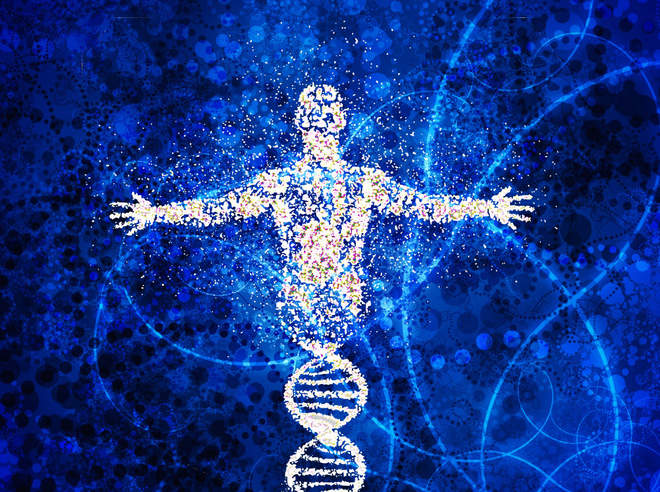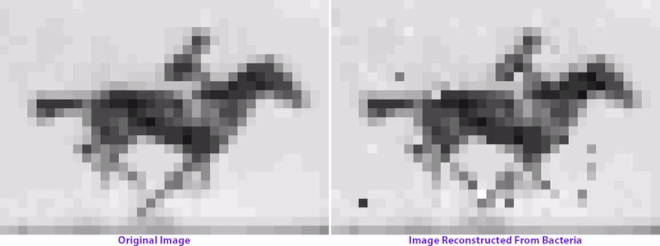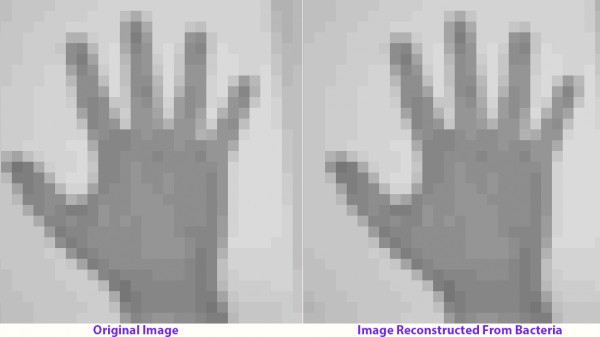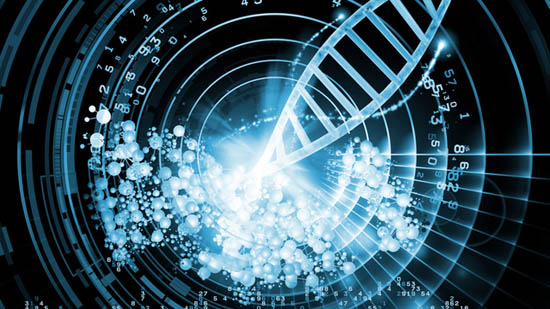This is the first GIF image to be stored on a microbe
In the future, when DNA is used as a place to store data, current hard drives will have to be ignored. With this "natural storage device", we will never have to bother with the huge storage of photos, music, and movies of up to hundreds of GB, even that huge data store will Follow you wherever you are because it is DNA itself.
- Found a way to "copy" knowledge directly into the brain like science fiction movies

The scenario that seems only in these sci-fi films will probably happen in the future. To prove that, scientists at Harvard used the CRISPR genetic modification system to introduce an animation into a genome of a bacterium Escherichia coli (E. coli species). Each individual pixel of the image is converted into nucleotides, the foundation bricks form a DNA.
The researchers gave a GIF of a total of five frames to a living bacterium, about a horsebacker photographed by a British photographer, Eadweard Muybridge. By rearranging the DNA sequence of the bacteria, they can extract the data and through reading the pixel codes in the nucleotide, the animation is reconstructed with an accuracy of up to 90%.

On the left is the original image, on the right is a photo recreated from bacteria.
Yaniv Erlich, a computer scientist and biologist at Columbia University after watching the study, said that this visual method could not only be applied to bacteria but could be applied to Information and data into living cells and in the future is on human cells.
According to him, anyone's DNA can be used to store information and become an extremely efficient USB data storage device. Evidence is that scientists can get data from DNA that lasts thousands, even millions, of years.

On the left is the original image, on the right is a photo recreated from bacteria.
Until now, scientists have done a lot of research on using DNA as a 'drive' to store data, but all are based on synthetic DNA. And this tiny 36 x 26 pixel GIF image is no exception, even the amount of data is much smaller than the record that scientists can store on a previously synthesized DNA. But uploading data to a living cell is a thousand times more difficult than putting data into a synthetic DNA, because living cells continuously move, change, divide and die.
According to Erlich, storing data in living cells has the advantage that information will be better protected. In some cases such as extremely high ambient temperatures, a nuclear explosion, when exposed to radiation, there are still bacteria that can survive.

Seth Shipman, a scientist working at Harvard, who led the experiment, added that he not only wanted to use DNA to store data but also wanted to use it to create "living sensors", can record what happens inside the cell and the environment around them.
Currently, this technology is an effective research tool to help scientists record very small events, occurring at the molecular level, from which they can observe the evolution and evolution of these Different types of cells that humans have not yet discovered.
You should read it
- Windows Store rolled over 150,000 applications
- Select memory card or cloud to save data?
- Part I: Hard drive connection standards
- USB flash drive, HDD and SSD: Which is the best option for you?
- The reason why you should only download the app from Play Store and App Store
- How to back up Facebook data to your computer
- Instructions for copying files on iTunes
- How to save React form data in Mongo Database
May be interested
- How to Search by Image
 this wikihow teaches you how to search the internet by uploading an image to a search engine like google image search, tineye, or bing visual search. searching by image allows you to find out where the image appears online, and also gives...
this wikihow teaches you how to search the internet by uploading an image to a search engine like google image search, tineye, or bing visual search. searching by image allows you to find out where the image appears online, and also gives... - 5 ways to add an image to another image
 whether you want to create a collage, card, or something else, it's easy to insert one image into another. keep reading to learn how to add an image to another image on your computer, browser, or mobile device, with instructions for each method.
whether you want to create a collage, card, or something else, it's easy to insert one image into another. keep reading to learn how to add an image to another image on your computer, browser, or mobile device, with instructions for each method. - How to view and delete Wifi passwords stored on the Laptop
 wifi network is becoming more and more popular, used in many places such as schools, agencies, cafes ... so how to view or delete the wifi password stored on your laptop.
wifi network is becoming more and more popular, used in many places such as schools, agencies, cafes ... so how to view or delete the wifi password stored on your laptop. - Japan officially declared victory in the war on floppy disks
 japan is one of the countries with the world's leading technological development, but there is a surprising thing that few people know: government agencies in this country are still requiring data to be stored or stored. submitted by floppy disk or cd.
japan is one of the countries with the world's leading technological development, but there is a surprising thing that few people know: government agencies in this country are still requiring data to be stored or stored. submitted by floppy disk or cd. - Tools that enlarge images without breaking the image
 you want to enlarge the image without losing the original image quality? use one of the solutions in this article.
you want to enlarge the image without losing the original image quality? use one of the solutions in this article. - What is raw? What is the Raw image file?
 the popular image formats such as .jpg, .png or .bmp are probably well known. but have you ever heard of raw? this is an important image file that anyone who is interested in photography needs to know. so what is raw image? what is different from the usual image formats like .jpg? the following article will explain to you.
the popular image formats such as .jpg, .png or .bmp are probably well known. but have you ever heard of raw? this is an important image file that anyone who is interested in photography needs to know. so what is raw image? what is different from the usual image formats like .jpg? the following article will explain to you. - How to Nest an Image Inside Another Image in Photoshop
 this is an article showing how to insert one image into another image using adode photoshop. adjusting the transparency and using additional gradient tools to process the images used for compositing will help you achieve this effect.
this is an article showing how to insert one image into another image using adode photoshop. adjusting the transparency and using additional gradient tools to process the images used for compositing will help you achieve this effect. - How to convert a PDF to a JPG image
 how to convert a pdf to a jpg image. in certain cases we need to convert the pdf file format to a jpg image format. because image files do not need to have any additional applications, just use the default image viewer application of windows
how to convert a pdf to a jpg image. in certain cases we need to convert the pdf file format to a jpg image format. because image files do not need to have any additional applications, just use the default image viewer application of windows - ChatGPT now has an image gallery: Here's what it does and how to use it!
 openai has just launched a brand new image library for chatgpt users — an overdue but welcome feature that finally gives you a way to view, manage, and review ai-generated images.
openai has just launched a brand new image library for chatgpt users — an overdue but welcome feature that finally gives you a way to view, manage, and review ai-generated images. - Extract the password saved on Chrome in .CSV format
 in the latest version of chrome web browser, google has added a new feature that allows users to export all password data stored in the .csv format.
in the latest version of chrome web browser, google has added a new feature that allows users to export all password data stored in the .csv format.










 The picture of the strange and controversial bridge over the past, the waste of idiots or constructive calculation
The picture of the strange and controversial bridge over the past, the waste of idiots or constructive calculation This is the world's most rare passport, only 3 people in the world own it
This is the world's most rare passport, only 3 people in the world own it The 10 brainwashing junctions in the world make you confused
The 10 brainwashing junctions in the world make you confused Admire the beauty of 10 tiny countries in the world
Admire the beauty of 10 tiny countries in the world The Earth used to be purple and 8 secrets of little surprise
The Earth used to be purple and 8 secrets of little surprise Discover the history and exciting production process of toilet paper
Discover the history and exciting production process of toilet paper